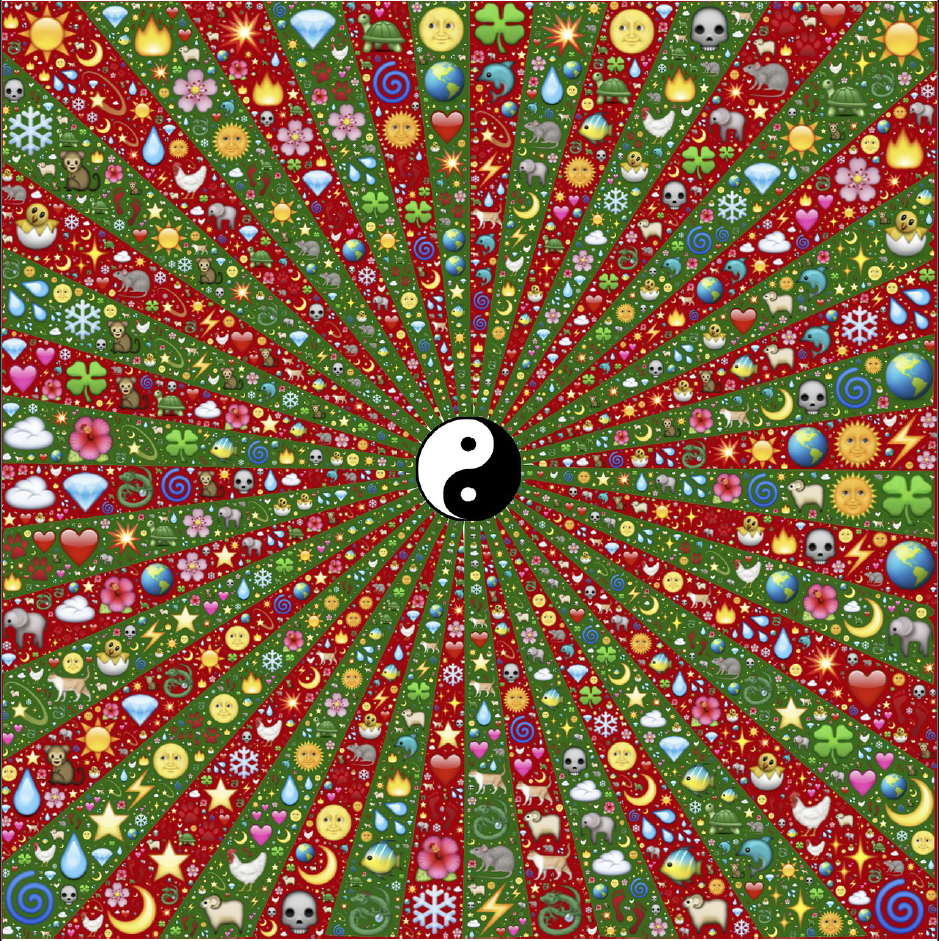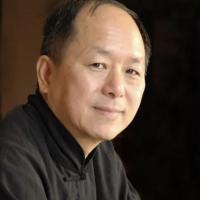An ancient document said: “The ultimate of movement is stillness, the ultimate of stillness is movement. To move is to generate stillness, and to be still is to generate movement. Therefore, (if you) use stillness as movement, (your) movement will be stronger every day. (If you) use movement as movement, (your) movement will weaken daily. (If you) use movement to drive stillness, (it is) calm and long. (If you) use stillness to drive the movement, (it is) vigorous and strong.”
古云:〝動極則靜,靜極則動,動以成靜,故以靜為動,其動日 強。以動為動,其動日弱,而以動馭靜,靜而可久。以靜馭動,動 而可大。〞
When the body is calm and still, the mind can be clear and concentrated. When the mind is concentrated, the Qì led can be abundant and, consequently, the physical power manifested can be strong. When you are active and moving, the mind is excited and harder to focus. Naturally, the power manifested will be weak. Therefore, it is said that if you use stillness and calmness to drive the movement, the action can be vigorous and strong. Moreover, if you know how to move slowly and calmly, you are able to keep the mind calm and peaceful. When this happens, the calmness of the mind can last long. However, if you keep moving fast, the mind’s concentration will be shallow, the Qì led will be weakened, and naturally, the power manifested will be weak. The aim of Tàijíquán is to keep the mind concentrated and calm within the movements. That is why Tàijíquán is also called “moving meditation.” The more you practice, the more you are able to concentrate. The mind becomes calmer and therefore, the movements can be stronger and stronger.
Reaching Extremities
Yīn is the beginning of Yáng, and Yáng is the start of Yīn. When Yīn reaches its extremity, it becomes Yáng and when Yáng reaches its extremity, it turns into Yīn. This is the rule of heavenly Dào (i.e., natural way). In the theory of Tàijíquán, calmness is Yīn and movement is Yáng. Within calmness, there is a hidden movement and within the movement, there is a calmness. What is the calmness? It is Yīn, it is Yì, and it is internal. What is movement? It is Yáng, has shape, and is external. When Tàijíquán is used for applications (i.e., power manifestation), storage is Yīn. When storage reaches its extremity, it becomes Yáng. Emitting is Yáng. When Yáng reaches its extremity, storage begins. To and fro, they mutually apply to each other.
陰者,陽之始。陽者,陰之初。陰極而陽,陽極必陰,此為 天道之理。太極拳理者,靜為陰,動為陽。靜中寓動,動中 有靜。靜者,陰也,意也,內也。動者,陽也,形也,外也。 太極拳用者,蓄為陰,蓄極而陽。發為陽,陽極而蓄。一來一 往,相互為用。..
When Yīn has reached its extremity, it turns into Yáng and when Yáng reaches its limit, it changes into Yīn. This is the natural rule or Dào. This theory is also applied in Tàijíquán practice. In order to generate Yáng, you must first have Yīn, and when Yáng has been manifested, the Yīn must begin again. In Tàijíquán, Yīn is internal, which is related to Yì and Qì, while Yáng is external, and is the manifestation of Yīn. When this rule is applied to Tàijíquán applications, Yīn is storage while Yáng is the manifestation of the power and the execution of techniques. Yīn and Yáng mutually generate and support each other.
But do remember that there is a hidden Yáng within Yīn and a (concealed) Yīn resides within Yáng. Yīn is not completely Yīn and Yáng is not completely Yáng. (Consequently,) Yīn and Yáng can then be mutually exchangeable, regulate each other appropriately, and the Jìng and skills can be alive. (If) Yīn is completely Yīn, the Jìng will be stagnant and stiff. (If) Yáng is completely Yáng, then the Jìng manifested will be hard to withdraw.
但切記陰中寓陽,陽中帶陰,陰不全陰,陽不全陽。陰陽才能 互變、互調得宜,勁技能活。陰而全陰,勁必呆死。陽而全 陽,勁必難收。...
In order to exchange Yīn and Yáng smoothly and skillfully, you should not allow your Yīn or Yáng to reach its maximum or extremity. When this happens, the exchange will become stagnant. If you allow some Yīn within Yáng and vice versa, the exchange will be smooth, comfortable, and natural. That is why, in the Tàijí Yīn-Yáng symbol, there is some Yīn hidden in Yáng and some Yáng hidden in Yīn. It is the same for Tàijíquán. Insubstantial and substantial should be able to exchange with each other smoothly and naturally so the Jìng manifestation will be alive.
What is Tàijí (in Tàijíquán)? It is the mind governed by Yì (i.e., wisdom mind). That means the original natural virtue of Tàijíquán is Yīn and is calmness. (It) looks for the movement within calmness. From the Yīn’s containment (i.e., storage) the Yáng can be emitted. Calmness is used as a foundation and the movement is used for applications. Use defense as the primary maneuver and use offense for secondary tactics. Search for offense in defense, wait for advantageous opportunity, and then emit. Calmness is to store, and movement is to emit. (If you) are able to understand the theory of calmness, then (you) can comprehend the applications of Jìng (i.e., martial power). From calmness, the spirit is hidden in Yì, the Qì is stored in the bone marrow, and external Jìng is hidden in the postures. From understanding Jìng, the advantageous opportunity can be perceived, and from knowing the advantageous opportunity, the Jìng can be emitted. When the calmness is deep, the emitted Jìng will be strong, and when the calmness is shallow, the emitted Jìng will be weak. Theoretically, this is not different from bending the bow to store the Jìng.
太極者,意宰也。亦即太極拳之本性,陰也,靜也。由靜中求 動,由陰含而陽發。以靜為本,以動為用。以守為主,以攻為 輔。守中求攻,待機而發。靜者,蓄也,動者,發也。能懂靜 之理,才懂勁之用。由沉靜而神匿於意、蓄氣於髓、隱外勁於 勢,由懂勁而知機,由知機而勁發。靜深則勁發強,靜淺則勁 弱。此與蓄勁張弓之理無异矣。..
We have already shown that the Tàijí in Tàijíquán is the Yì’s governing (i.e., the wisdom mind). Yì is internal, which belongs to the Yīn aspect of Tàijíquán. Therefore, it is calm and peaceful. From this calmness, the Yì can be highly concentrated, and its storage can be profound. When this Yì is deep and profound, the feeling will be accurate and refined. You should always remember that feeling is the language of the mind and the body’s means of communication. Deep and accurate feeling allows you to manifest the mind’s decision precisely and quickly. From this, you can see that the Yīn (i.e., the Yì) is the foundation of Tàijíquán’s Yáng manifestation. Tàijíquán is a defensive martial art and uses defense as offense. Waiting for opportunity through attaching, connecting, adhering, listening, and following, enables techniques to be executed properly and the power to fully manifest. When this happens, you will know the opponent, but the opponent will not know you. This is the stage of Understanding Jìng. Tàijíquán’s Jìng storage is the same process as storing power by drawing a bow. If you are calm, firm, and concentrated, the Jìng can be stored to its most efficient stage. When this stored Jìng is manifested, its execution can be accurate, and the power can be strong.
The above is an excerpt from Taijiquan Theory of Dr. Yang, Jwing Ming, 2nd Edition; The Root of Taijiquan (Tai Chi Chuan), Publication Date June 2023, YMAA Publication Center, ISBN: 9781594399022.


